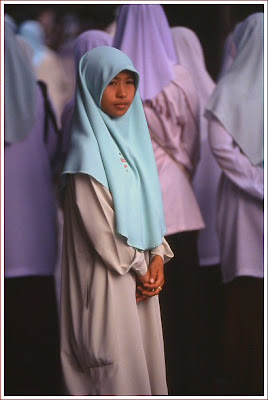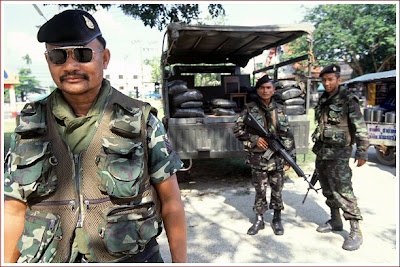“Burma is currently a land where there is no human security and where several millions are displaced externally as refugees or illegals in neighbouring countries. Burma and Shan state is a land where hundreds of thousands are dispossessed, dislocated, and hunted down like animals by army columns and search and destroy patrols. It is a country where almost everyone is without hope, living lives of utter desperation in abject poverty, without a shred of dignity or human rights of any kind” -
On the opposite side of Thailand’s far northwest border, in Burma, is a large mountainous region called Shan State.
Everyday refugees and drugs flow across the border from Shan State into Thailand.
In order to understand what refugees are fleeing from and why drugs continue to flow across the border it is necessary to understand the dynamics of drug production, resistance armies, and Thai policy towards refugees.
Burma is the second largest producer of heroin in the world and the majority of its poppy fields and drug refineries are located in Shan State.
Shan State is also home to a bewildering array of armed factions and most of them have been locked in a seemingly intractable conflict with the government of Burma.
How the politics of drug production mingle with the politics of armed resistance is often misunderstood and insurgent armies are mistaken for narco-armies.
In order to understand the various armed factions it is important to first clarify drug production in Shan State.
Along with the more traditional opium/heroin production there is a booming methamphetamine industry.
Yaba (ยาบัา or ‘crazy medicine’ in Thai) is produced from a cocktail of chemicals, with minimal labour, in drug labs lining the Thai border.
The primary motive is profit, the market is largely confined to Thailand and China, and the business is dominated by apolitical drug runners.
Opium, in contrast, is an agricultural product that a large number of peasant farmers depend upon for their livelihood.
It is transported by farmers to local market dealers who then take the raw opium to a broader network of dealers, primarily Chinese, who render it down into a more concentrated form or refine it into heroin 'number 4’.
It is then transported by large drug syndicates across the Thai and Chinese borders where it then joins the world market.
The armed factions that operate in and around Shan State cross the whole political spectrum from ethnic nationalists to the Burmese military to multi-ethnic communists to Chinese Nationalists to well armed criminal gangs.
All armed factions are somehow linked to the drug trade.
Ethnic nationalist armies are primarily associated with opium/heroin through the taxation of trade goods passing through their territories.
Many of the ethnic nationalists, such as the Shan State Army, have/are attempting to wean their economic dependence away from drug profits and to end the growing of poppies within their spheres of control.
The Burmese government and its military, the Tatmadaw, may not be active in drug production yet they are a main beneficiary of the profits and are directly responsible for creating a drug based economy in Shan State.
The grotesque economic failure of ‘Burmese socialism’ dismantled the country’s economy to such an extent that paper currency, the Burmese kyat, became worthless. The economy reverted back to the bartering of commodities.
In Shan State, opium became the principle commodity because it is easy to transport, can be stored for long periods, and is far more valuable than any other agricultural crop farmers can grow.
The opium economy in Shan State has also been encouraged by the Tatmadaw’s brutal 'four cuts' military campaign.
The four needs of insurgent armies were deemed to be access to food, finance, recruits, and intelligence and the Burmese military launched a campaign to eliminate those resources.
The campaign directly targeted the civilian population with search and destroy patrols that murdered, tortured, raped, and confiscated land and property from peasants in order to cut any supplies from reaching insurgent armies.
Opium became the single commodity that peasants could take with them when fleeing from rampaging Tatmadaw patrols.
Flourishing in the chaotic environment are the remnants of the Kuomintang (KMT or Chinese Nationalists) army and various criminal gangs.
The KMT have been involved in drug production in Shan State since retreating from China after Mao’s victorious communist revolution in 1950.
Being capitalists, and rationalizing their need to purchase arms as well as being apathetic to Shan nationalist aspirations, the KMT were uniquely qualified to revolutionize the opium trade.
Their global connections to Chinese diaspora afforded them both the global reach and capital to reap enormous profits from drugs.
Criminal gangs, with various allegiances and ethnicities, account for the rest of the drug trade.
As many Shan State residents are internally displaced by the political chaos and endless conflict they are being pushed up along and over the Thai border.
How refugees are received in Thailand is a reflection of the Thai held stereotype that everyone from Shan State is either a drug runner or an insurgent soldier.
Refugee camps lining the border are filled with Shan State residents who have fled conflict and the Tatmadaw but live as prisoners surrounded by barbwire fences and bristling with Thai military sentries.
More worrying has been Thai Prime Minister Thaksin’s ‘war on drugs’.
In a reactionary and ineffectual response to the flow of drugs, particularly the near epidemic use of yaba in Thailand , Thaksin launched a draconian extermination campaign against drug dealers.
Because Shan State is a major source of drugs, the power of the police and military has been unleashed and focused upon the border.
Low level drug dealers, suspects in rural and poverty stricken villages, and often those with out any connection to drugs, were not just at risk of mass arrests but were at risk of state-sanctioned assassination.
Approximately 3000 extrajudicial killings have been carried out by joint military/police patrols under the orders of Prime Minister Thaksin.
The aggregate result of both drug production and politically diverse armies in Shan State and the hostile reception that refuges receive in Thailand has been the immense suffering of peasants caught between armed factions, drug production, and international borders.
The one simple truth, and articulated in the opening quote, is the abysmal conditions forced upon the average resident of Shan State.
 “The issue is not one of the separation of church and state…for there is no church in Islam. The issue is one of legitimacy: what kind of state and what kind of community? Does legitimacy come down from the divine to the one man, the halife, shadow of God on earth and thence to the ulema and to human society, or does legitimacy arise from a free and open exercise of political rights? The question is indeed central to Islam, and has been central from the very beginning.”
“The issue is not one of the separation of church and state…for there is no church in Islam. The issue is one of legitimacy: what kind of state and what kind of community? Does legitimacy come down from the divine to the one man, the halife, shadow of God on earth and thence to the ulema and to human society, or does legitimacy arise from a free and open exercise of political rights? The question is indeed central to Islam, and has been central from the very beginning.”

